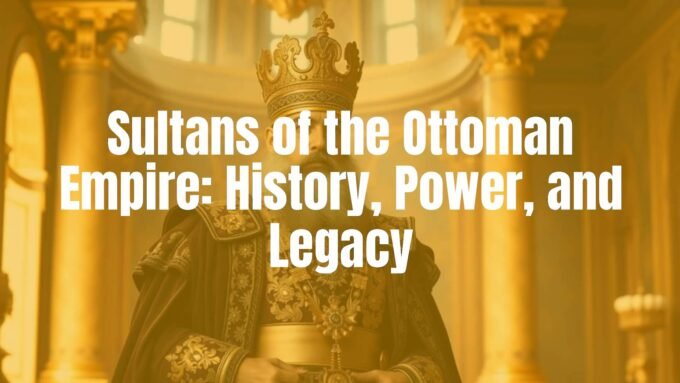Ancient Turkey, often called Anatolia or Asia Minor, was not a single culture. It was a mix of many peoples and empires that rose and fell over thousands of years. Its place between Europe and Asia made it a key crossroads for rulers, traders, and travelers. This position led to steady exchanges of ideas, tools, beliefs, and foods. Each new power changed the region’s language, buildings, food, and religions in lasting ways.
The history of today’s Turkey covers both Anatolia (the Asian side) and Eastern Thrace (the European side). The Bosphorus Strait separates them, but several empires joined them under one rule, especially the Roman and later Byzantine Empires. These lands became the base for the country we know now.
Where Was Ancient Turkey Situated?
Anatolia is a broad peninsula with the Black Sea to the north, the Mediterranean Sea to the south, and the Aegean Sea to the west. This location made it a natural stop for migration and trade. It was where East met West.
Because of this, Anatolia saw a steady flow of new cultures and ideas. Its fertile soil and rich metal deposits drew many groups to settle there. From early villages to mighty states, the land’s features shaped its role as a meeting place for many cultures.

Why Was Anatolia a Key Crossroads in Antiquity?
Anatolia sat on the fastest land route between Asia and Europe. Any empire that wanted reach across both continents had to deal with Anatolia. This made the region a place of constant contact, from trade to war.
The land also had good farms and important metals for early toolmaking. This mix of useful land and a central position kept Anatolia at the center of human goals-trade, farming, mining, and state building-all of which shaped ancient history.
What Are the Main Characteristics of Ancient Civilizations in Turkey?
Ancient groups in Turkey showed some shared traits, shaped by their place on the map and steady waves of new people.
- Adaptation: Newcomers often blended with older groups, mixing languages, beliefs, and customs.
- Innovation: Advances in metalwork, building, and early government were common.
- Art and religion: Large temples, rock tombs, and carved stones point to rich craft skills and many gods tied to nature.
From Göbekli Tepe’s stone circles to Lycian tombs, the record shows a long line of layered cultures still being studied today.
Chronology of Civilizations in Ancient Turkey
The timeline in ancient Turkey runs from the earliest stone tools to complex states. The steady line of activity shows how early ideas in farming, metalwork, and rule set the stage for later empires.
Knowing the sequence helps us see how each period built on the last and how Anatolia helped shape wider human history.
| Period | Approx. Dates | Highlights |
|---|---|---|
| Paleolithic | to c. 10,000 BCE | Early humans, stone tools, cave life |
| Mesolithic | c. 10,000-8,500 BCE | Coastal camps, hunting and gathering |
| Neolithic | c. 8,500-5,000 BCE | Farming, animal care, first settled towns |
| Chalcolithic (Copper Age) | c. 5,000-3,000 BCE | Copper tools, early metal use |
| Early Bronze Age | c. 3,000-2,000 BCE | Bronze tools, trade growth, city-states |
Paleolithic and Neolithic Cultures in Anatolia
People lived in present-day Turkey as far back as the late Paleolithic. A stone tool from the Gediz River, dated to about 1.2 million years ago, and finds near Istanbul, Antalya, and other shores show long-term use of caves and shelters. Fruits and animal bones found there tell us about early diets and daily life.
The Mesolithic (10,000-8,500 BCE) kept this pattern, especially along the Mediterranean coast. The Neolithic (8,500-5,000 BCE) changed everything. Around 10,000 BCE, farming and animal care began. Settled life took shape in southeastern and central Anatolia between 11,000 and 9,000 BCE. Sites like Göbekli Tepe (nearly 12,000 years old) and Çatalhöyük (often called the first known town, around 6500 BCE) show early shared spaces, strong art, and organized living.

Chalcolithic and Prehistoric Developments
In the Chalcolithic (5,000-3,000 BCE), people started making and using copper tools. Anatolia’s rich ores helped metalwork grow. This period saw tighter village life and better tools and crafts.
These steps set up the move into the Bronze Age, where metal use and social order grew stronger. Anatolia kept its place as a center of early progress.
The Rise of Early Bronze Age Societies
In the Bronze Age (3,000-2,000 BCE), bronze tools spread widely. Trade with nearby regions grew, fed by demand for metals and local skill. Finds near royal graves confirm broad use of bronze.
Late in this age, new groups arrived. The Hatti set up small city-kingdoms in central Turkey and spoke Hattian, a local language. The Hurrians moved in from the Caspian area, bringing their own language and beliefs. These groups, along with others, formed the base for later empires.
Major Ancient Civilizations of Anatolia
Anatolia hosted several major powers. The Hittites challenged Egypt. Troy filled poems and had real walls and houses. Lydia grew rich from gold and silver. Their remains and ideas spread far beyond their borders and shaped later ages.
Studying these groups shows how active and important ancient Turkey was in human progress and contact.
Hatti and Early Anatolian States
The Hatti lived in central Turkey during the late Bronze Age (c. 2,500-2,000 BCE). They formed city-kingdoms and spoke Hattian, a language with no known modern relatives. They traded through posts called Karums, working with Assyrians to get materials for bronze. This trade brought writing to the area, and both Hattians and later Hittites used cuneiform for records.
The Hurrians, coming from near the Caspian Sea, also settled widely. They often fought neighbors and spoke Hurrian, also used in northern Syria. These groups later mixed with and were absorbed by rising Hittite power, creating a rich cultural base for later states.
The Hittite Kingdom: Expansion and Legacy
The Hittites (c. 1750-1200 BCE) were one of Anatolia’s strongest powers. They were Indo-European speakers who moved into the region over time, setting up a central state with its capital at Hattusa. The ruins, including the Lion Gate, still stand.
The Hittites built a wide empire, from the Black Sea to Damascus, covering much of central Turkey. They were the main rival to Egypt in the Near East. Other Indo-European groups, such as Palaians and Luwians, lived nearby. Hittite is the oldest known Indo-European language with written records. Their buildings, records, and laws show strong organization; many artifacts are in the Ankara Archaeological Museum.

Hurrians and the Kingdom of Mitanni
The Hurrians used a non-Indo-European language and spread across Anatolia and northern Syria from c. 2500 BCE onward. They shared space with the Hatti and later had frequent contact with the Hittites during the Great Hittite period (1750-1200 BCE).
Their peak was the Kingdom of Mitanni in northern Mesopotamia and Syria. Mitanni dealt and sometimes fought with the Hittites. While different in language and some customs, the Hurrians added to the varied cultural map of ancient Turkey.
Troy: Myth and Archaeological Reality
Troy is famous from Homer’s The Iliad, but it was a real city in northwest Anatolia near the Dardanelles. The earliest levels date to about 4500 BCE. Troy was an important port with a long life.

The Phrygian Civilization and Midas
After the Hittites fell and the Trojan War ended around 1200 BCE, the Phrygians rose (c. 1200-700 BCE) in west-central Turkey. Their capital was Gordium near modern Ankara, with sites also near Kayseri. They spoke an Indo-European language closer to Greek than to older Anatolian tongues.
Legends tell of King Midas and King Gordias with the Gordian Knot. Excavations at Gordium reveal roads and rich remains. Though their central rule seems to have been weak, their culture mattered, even showing up in early Christian writings. The Cimmerians attacked around 650 BCE, and Phrygia faded as an independent power.
Urartu in Eastern Anatolia
Urartu ruled in eastern Anatolia from about 900 to 600 BCE. They spoke a non-Indo-European language and centered their power around Lake Van. This spot let them control trade and farms.
They often fought the Assyrians but held their ground and even spread into areas now in Armenia and Georgia, reaching the headwaters of the Tigris and Euphrates. Their story is important in Armenian history. Attacks by the Medes and Scythians in the 7th century BCE ended their rule, but their fortresses and culture remain notable.
Lydia, Caria, and Lycia: Aegean Powers
On the Aegean coast, Lydia, Caria, and Lycia grew strong, especially in the 7th and 6th centuries BCE.
- Lydia (west of Phrygia): Rich in gold and silver; first to mint gold and silver coins; capital at Sardes; later taken by Persia, then by Greeks and Romans.
- Caria (south of Lydia): Close ties with Greeks and Minoans; known for seafaring; often under larger empires but kept a local identity until the Byzantine period.
- Lycia (Teke peninsula): Famous for rock-cut tombs; more than forty ancient cities found; later part of Roman, Byzantine, and modern Turkish states.
Ionian Greek City-States
From about 1200 BCE, Aeolian and Ionian Greeks settled along western Anatolia. Cities like Miletus, Ephesus, and Smyrna became key centers. They began as farming communities but grew fast with contact from Egypt, Assyria, and Phoenicia. They produced early science, philosophy, art, and literature.
Ionia is often seen as the birthplace of Western science and thought. The Temple of Artemis and the Library of Celsus in Ephesus show their grand style. Over time, these cities came under Persian, then Hellenistic, and later Roman control, but their impact on culture stayed strong.
Foreign Rule and Empire Building
Anatolia’s rich land and key location drew large empires. Over time, many small kingdoms were folded into bigger states. New rulers brought fresh systems of rule, languages, and faiths, changing the region in lasting ways.
Persian order, Alexander’s spread of Greek culture, and Rome’s long rule all shaped Anatolia and tied it to wider networks across continents.
Persian Conquest of Anatolia
The Achaemenid Persian Empire, founded by Cyrus the Great around 550 BCE, took control of Anatolia from 545 to 333 BCE. This ended the freedom of many local states, including Phrygia and Lydia. The Persians divided the land into satrapies, each led by a governor. This system worked well and made port cities busy and rich.
The period was fairly stable. Taxes were organized, and big roads and works were built. The Great Royal Road linked Susa to Sardis and sped up trade, messages, and armies. Some satraps rebelled at times, but the empire held. The Ionian Revolt in western Anatolia later set off the Greco-Persian Wars, which shaped later European history.
Alexander the Great and the Hellenistic Age
Alexander the Great ended Persian rule in a few years (334-330 BCE) by defeating Darius III. Greek language and customs spread widely in the lands he took, including Anatolia.
Alexander used Anatolia as a base for campaigns farther east. Legend says he cut the Gordian Knot at Gordium, a sign he would rule Asia. After his death in 323 BCE, his generals split the empire into Hellenistic kingdoms, several of them in Anatolia. Greek art, learning, math, and science flourished. This wave of Greek culture set the scene for Rome’s later rule.
Roman Rule and the Transformation of Anatolia
By the 2nd century BCE, Rome began to control parts of Anatolia, which had been divided among Hellenistic states. Rome defeated the Seleucid Empire in battles like Thermopylae and Magnesia, and the Treaty of Apamea (188 BCE) pushed the Seleucids out of Anatolia. The Kingdom of Pergamum was later willed to Rome in 133 BCE, creating the province of Asia with Ephesus as its capital.
At first, Rome allowed much local rule while guarding the region. Greek language and culture spread even more under Rome, and many local languages faded. Trade brought wealth and peace for long stretches. Roman engineering added arches, vaults, domes, aqueducts, bridges, big bath complexes, and broad streets. Christianity spread quickly across Anatolia; St. Paul founded many early churches known as the Seven Churches of Asia Minor. This period prepared the way for the later Byzantine era.

Byzantine and Early Medieval Civilizations
As Rome weakened and split, Anatolia became the core of the Eastern Roman Empire, later called the Byzantine Empire. This long period brought big changes in faith, art, and politics. Constantinople rose as a leading city, while Christianity grew and Byzantine art and building styles shaped the land.
Roman law, Greek culture, and Christian belief came together in a distinct way. The results influenced the early medieval period and left a long legacy in Turkey.
The Byzantine Empire in Anatolia
The Byzantine period began in 330 CE when Emperor Constantine made Byzantion the new capital, renaming it New Rome, later Constantinople. After the Roman Empire split for good in 395 CE, Constantinople became the capital of the Eastern Roman Empire. This state ruled most of modern Turkey until the Late Middle Ages and kept Roman traditions while adding Christian and Greek elements.
Anatolia supplied soldiers, food, and a shield against eastern rivals. The borders rose and fell, with many wars against the Sassanids, which wore both sides down and opened the door to later Muslim advances. Even with these pressures, Constantinople remained a leading city for over a thousand years. The city fell to the Ottomans in 1453, yet Byzantine influence on Turkey’s culture and faith stayed strong.
Religious and Cultural Developments
During the Byzantine era, Christianity became the main faith in Anatolia. It had started to spread earlier under Rome, thanks in part to Saint Paul. Major church councils that shaped Christian belief met in cities in today’s Turkey: Nicaea (325 CE), Constantinople (381 CE), Ephesus (431 CE), and Chalcedon (451 CE).
With Constantinople as capital, the empire made Christianity the official religion in 380 CE and banned pagan worship in 392 CE. Roman, Greek, and Christian elements blended into a new style of art and thought. Hagia Sophia, built under Justinian, stood as the largest church in Christendom for centuries. Poetry, theology, and classical studies thrived among the elite. This mix gave Anatolia a rich culture that influenced later times.
Ancient Sites and Archaeological Discoveries in Turkey
Turkey is full of ancient remains. From early stone circles to busy port cities and carved tombs, the land offers clear traces of how people lived long ago. These places show how people built, worshiped, farmed, and traded.
New finds keep changing our picture of early life, social order, and technology. Turkey’s sites are key to learning about human history worldwide.
Göbekli Tepe and Neolithic Temples
Göbekli Tepe in southeastern Turkey is often called the world’s first temple. It dates from about 9500 to at least 8000 BCE, long before Stonehenge and the pyramids. It has large round structures with huge T-shaped pillars, the oldest known megaliths. Many pillars show carved animals and human-like details, giving rare clues to early belief and art.
First noted in 1963 and understood in full by Klaus Schmidt in 1994, Göbekli Tepe shows that big building projects and organized groups existed early. Recent work points to some settled life nearby, with houses and grain processing, along with ritual use. Named a UNESCO World Heritage Site in 2018, only a small part has been dug so far, and research continues.
Çatalhöyük: Dawn of Village Life
Çatalhöyük in south-central Turkey is often described as the earliest known town, around 6500 BCE. Its houses touched each other, and people entered from the roofs, forming a dense community without streets like we know them.
Finds include farm tools, signs of early animal care (including dogs), wall paintings, reliefs, and goddess figurines. These remains show daily work, belief, and art in a growing village society.
Notable Castles, Cities, and Tombs
Across Turkey, ruins tell stories from many ages. Hattusa, the Hittite capital, still has strong walls and the Lion Gate. Troy shows city walls, houses, a temple, and a theater from different periods.
Lycia’s rock-cut tombs line cliffs, with more than forty cities recorded. Ionian cities-Ephesus, Miletus, Smyrna-hold grand remains like the Temple of Artemis and the Library of Celsus. Roman works include aqueducts, bridges, and large baths. Early Christian sites tied to St. Paul’s churches-Pergamum, Thyatira, Smyrna, Sardis, Philadelphia, Laodicea, and Ephesus-also stand out. Together, these places map the long, varied story of ancient Turkey.
Why Ancient Turkey Civilizations Matter Today
The cultures of ancient Turkey still affect our lives. Their ideas, tools, and art shaped later science, trade, religion, and government. They also feed today’s identity in Turkey and draw people from around the world to learn and visit.
Looking at these past cultures shows how linked human history is and how much of today rests on work done long ago in these lands.
Contributions to Art, Science, and Technology
Many lasting advances came from Anatolia and its coastal cities:
- Art: Murals and reliefs at Çatalhöyük; monumental carvings at Göbekli Tepe; fine crafts across Anatolia.
- Metals: Hittite skill in bronze and later iron supported farming, war, and trade.
- Government and law: Early organized states and legal codes shaped later systems.
- Thought and science: Ionian cities fostered early math, astronomy, and philosophy.
- Money and trade: Lydians minted the first gold and silver coins, changing commerce.
- Engineering and architecture: Roman bridges, baths, aqueducts, and Byzantine marvels like Hagia Sophia.
Legacy in Modern Turkish Culture and Identity
Modern Turkey carries many layers from Hittites, Phrygians, Greeks, Romans, Byzantines, Seljuks, and others. Place names keep old roots alive. Sites across the country are protected and valued.
Patterns in art, foods, and ideas show both Eastern and Western threads. This long past gives people in Turkey a sense of continuity and pride, weaving ancient and modern life together.
Tourism and World Heritage Sites
Turkey’s ancient sites draw millions each year, and many are UNESCO World Heritage Sites. Göbekli Tepe attracts scholars and travelers who want to see the earliest megaliths.
Troy, Ephesus, Lycian tombs, and Byzantine Istanbul offer direct contact with long spans of history. These places teach visitors about human growth over time and support the economy. Care and preservation help keep these treasures available for future generations and keep the story of ancient Turkey alive.














Leave a comment